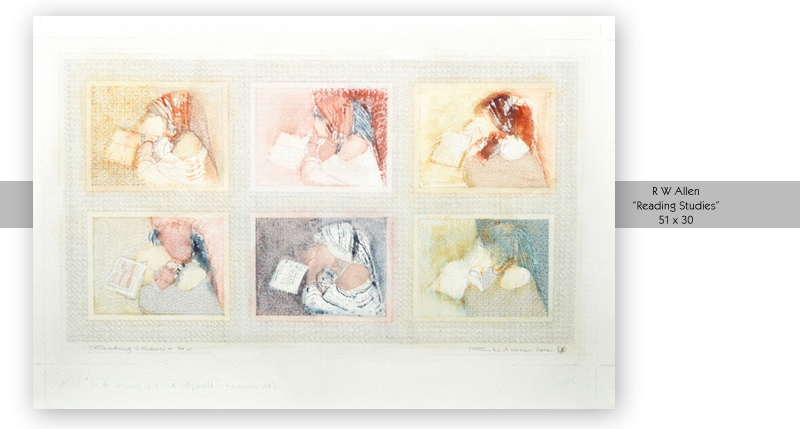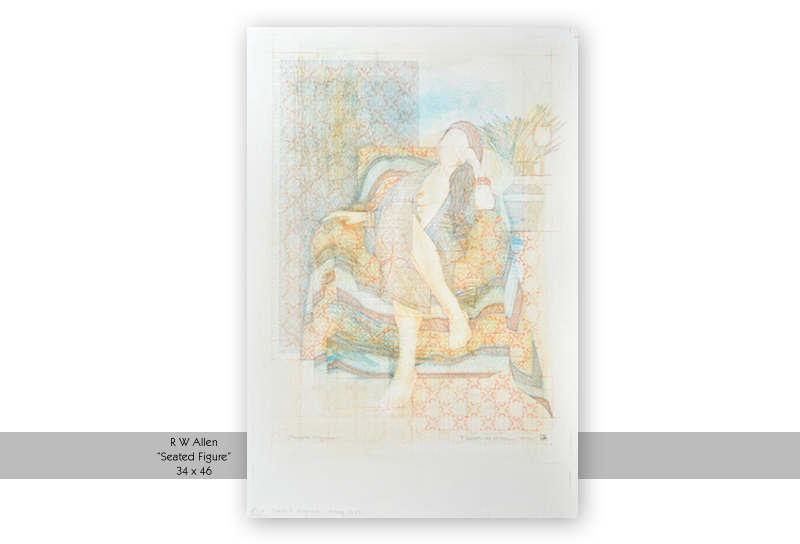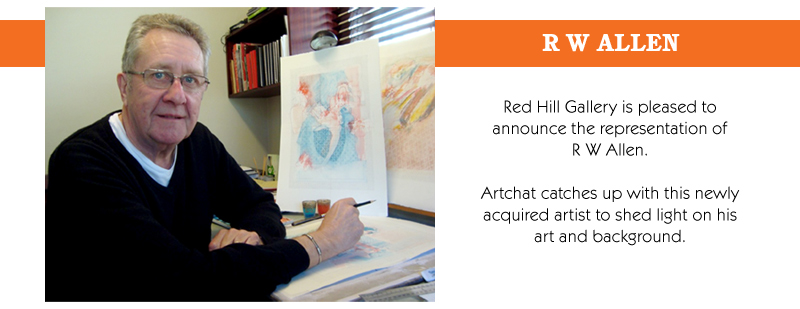AC: Describe your art in three sentences.
RWA: My work is essentially watercolour drawing. The female figure in an embellished interior is the single-minded subject of my explorations, with private costumed and styled model sessions held on a regular basis. On each occasion four hours are allocated, and during this time drawn studies are made and “sketchbook” photographs taken to gather comprehensive reference material from which all my pictures are prepared.
AC: Your work is delicate, intricate and intrinsically beautiful. How did you develop this style?
RWA: It is flattering that you refer to the work as “intrinsically beautiful”, and I guess that the “style” has evolved through time and from a number of sources. These include experimentation with gestural-based painting in my art school days back in the early 1970s, and an innate interest in geometry and pattern.
When I began working at the drawing board on a full time basis, it seemed appropriate to begin by re-examining previous experiences – to work with them, developing and refining through practice. Instinct is a valuable guide.
AC: Without revealing your secrets, how do you achieve the replica of the patination in the tiled images?
RWA: I am absorbed in an approach through which transparent layering is constructed using a combination of paint, wash, coloured and hardish [F H and 2H] drawing pencils. Erasing is integral to the process and various types are employed including stencil brushes. The paper [425gsm] is made of pure cotton and the closely interwoven fibres offer a durable structure – very robust and “giving” to this method of ‘addition and subtraction’ into the surface.
AC: What draws you to the subject matter that you do?
RWA: There are three artists whose work I find myself constantly re-visiting:- Henri Matisse, Pierre Bonnard and Edouard Vuillard. I am drawn to the vibrancy of their painting, and also their individual treatments of pattern portrayed in garments, supporting furnishings and objects, fabrics and drapes. Above all, Matisse’s stunning odalisques, usually reclining in a provocative pose and exotically clad, remain the greatest source of inspiration.
AC: When did art become a viable career choice for you?
RWA: Not sure if “career choice” is quite the right term . . . To date, I have led a privileged professional life that has included a number of teaching positions along with over twenty five years of commercial design output and management. It was during 2007 that I decided to take the steps necessary to pursue art interests on a full time basis. Work “at the drawing board” commenced in January 2010, and the timing was right as I had the almost immediate realisation that this is what I should be doing.
AC: Now for the fun questions! What is your favourite fashion accessory?
RWA: I wear a silver ingot on a neck chain, and the piece has been a constant ‘companion’ since my then girlfriend Agnes [and now wife for 33 years!] gave it to me back in 1978.
AC: What can you not live without?
RWA: Ag – friends – travel – the aroma of fresh bread and sizzling bacon – Marvin Gaye’s album “What’s Going On” – a long cool drink on a hot day . . . . .
AC: When you are creating what music do you listen to?
RWA: Apart from Marvin Gaye? I am a big fan of Dance, Trance and Trip-Hop. “Massive Attack” is regularly featured on the player in my workroom. The character, mood and tone kind of takes me into “the zone”. On occasions this assists greatly with aspects of my work which require quantities of repetition. I write down particular tracks I am listening to as a part of a daily journal/log.
AC: And finally, what is next for R W Allen? What are you working on, and what can we expect from you in the future?
RWA: As mentioned earlier, the direction is pretty much single-minded, and I am wholly focused on developing my craft through practice, and from both drawn and photographic reference produced during the sessions with my models.
I find it of great interest that Bonnard, and especially Vuillard, employed personal photographs as a tool for their work. Edgar Degas commented on the use of photographs by saying: “To combine the snapshot with the endless labour of the studio . . . . . the instantaneous given enduring quality by the practice of intense meditation”.
As I continue developing this particular process of drawing I am beginning to understand a sense of Degas’ descriptive sentiment . . . . .

© www.redhillgallery.com.au






